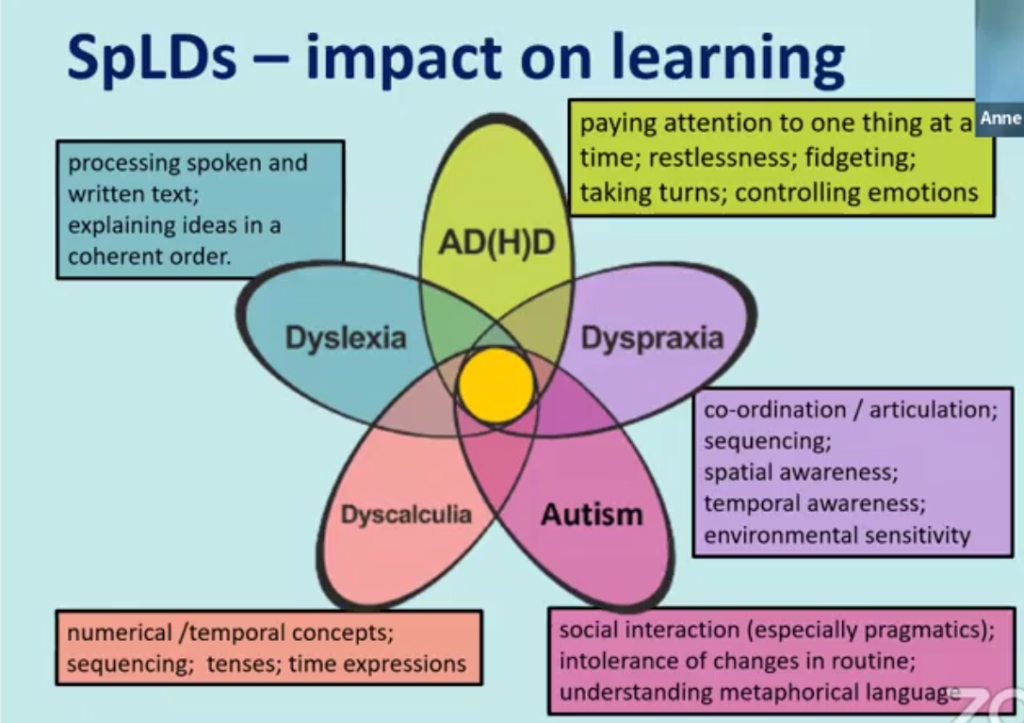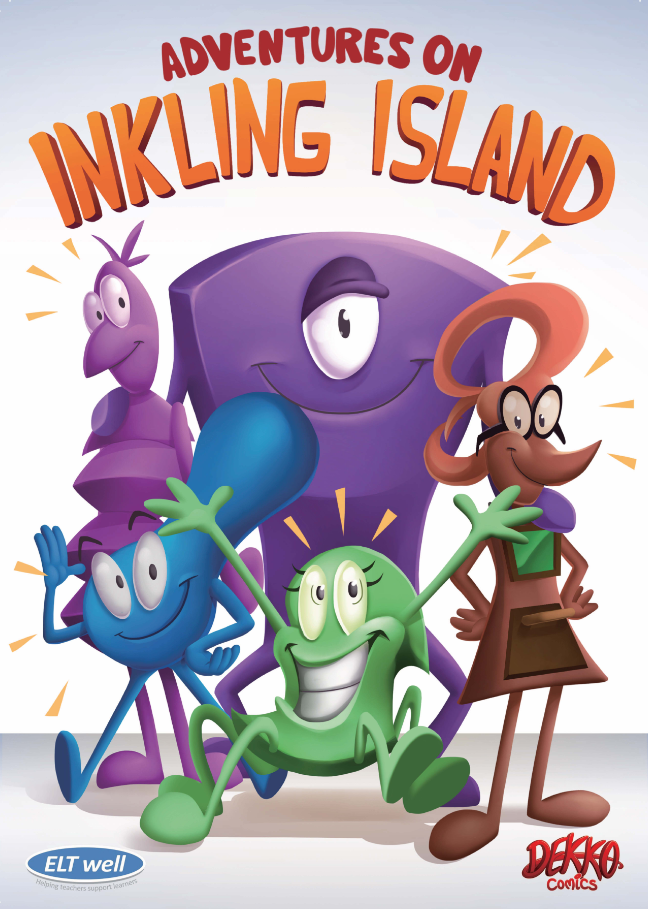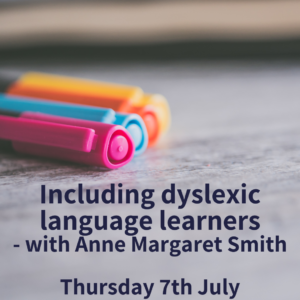Anne Margaret has kindly shared the slides from her presentation and you can also find more information and resources on her website, ELT well. I was really looking forward to this session because, as I mentioned at the start, I feel I have no experience of working with dyslexic language learners, though this could be because I haven’t had the tools to recognise them.
Anne Margaret said that this was probably a common situation for many ELT teachers as we often aren’t given specific training to recognise or work with SpLDs (specific learning differences).
She started the session by identifying five typical SpLDs: dyslexia, AD(H)D, dyspraxia, autism and dyscalculia. We discussed a little how it can be difficult to spot neurodivergence in second language learners, particularly if we don’t know our learners well. One issue that Anne Margaret highlighted is that dyslexia often becomes more obvious through literacy – which in English language learning often lags behind due to the challenges of orthography. She also noted that these SpLDs will be recurring and often have more than one manifestation, so we shouldn’t automatically assume that a fidgetty, restless student has AD(H)D.
She added that there is common ground between all these SpLDs – the yellow dot in the middle – which affects (working) memory, speed of processing, organisation and self-esteem, all leading our learners to have (extremely) good and bad days.
An important point to remember as well is that even if a learner has been identified as having a particular SpLD, they may also have traits of other undiagnosed SpLDs. Similarly, what it means for one learner to be dyslexic may be very different for what it is for another. We should approach each learner as an individual to identify what support they need in the classroom.

Anne Margaret went on to say that these aspects of crossover in the yellow dot are things we can work on with all learners. You can help learners develop tools to aid with memory and recollection and whilst you can’t increase a learner’s speed of processing, you can include simple hacks such as “answer at least five questions of ten” – allowing those learners who need more time to complete the minimum without needing to provide extra tasks for other learners. In terms of organisation, we can help our learners by using the tools they have available. For example, she joked that whilst learners may lose their homework, they never use their phones – so get them to set reminders on their phone or make notes on their phone. Sharing their own organisational strategies also helps to boost their self-esteem as it helps them to recognise what works well for them (their strengths) and also builds community in the classroom. She also suggests providing opportunities for learners to let you know if they’re having a good or bad day – building trust with your learners in this way will make them feel more comfortable coming to class.
Before moving on to talk about some other practical ideas, Anne Margaret mentioned some other typical SpLDs which can co-occur with those previously mentioned: DLD (developmental language disorder), prosopagnosia, OCD (obsessive compulsive disorder), Tourette’s syndrome and more.
"At the heart of inclusive practice in the classroom is the culture that it's OK to be you."
Anne Margaret identified three ingredients for learning:
- the classroom environment
- materials and tasks
- relationships
The classroom environment
There are a number of things we need to consider in the physical environment: temperature, lighting, noise levels, furniture / equipment and layout. With the classroom temperature, it might be something which you as the teacher have little control over as you may not be able to adjust the heating or open the windows. One suggestion she has is to recommend learners come in layers so they can easily adjust their own environment. With lighting, it might be worth having learners sit where they feel most comfortable if possible; with noise levels, it may be possible to allow learners to listen to their own music when working independently. You can also consider how close learners are to each other and whether some learners require more space and lead a discussion with the group on what would work best for them and alternatives which might be effective for the whole group.
Materials
There are things you can do to support learners for example having a clear layout, including multisensory activities, setting a realistic pace and considering the amount of content, and representing different lived experiences in your materials – on this topic, you may be interested in checking out the session from the Raise Up! team or Lottie Galpin’s talk on representing disability. For the clear layout, she also suggested making a simple ‘window’ with two L-shaped pieces of card which learners can place in their books or over materials to help them focus their attention on a particular activity. She also had a great idea for using Cuisenaire rods to help learners with questions and statements.
Tasks
Anne Margaret advised breaking tasks into small steps and adding in lots of moments to recap, review and revise. She also said that it’s essential to give explicit instruction and feedback (which is general good practice in ELT anyway!).
You can find more ideas in her books: Including Dyslexic Language Learners and Language Learning and Musical Activities. There’s another book edited by Anne Margaret, Activities for Inclusive Language Teaching.
Relationships
She highlighted the importance of respecting each other’s differences in the classroom and how key acceptance and belonging and in an inclusive classroom. This also helps you when considering pairings and groupings. We should also always look for the positive and praise learners authentically for what they do well.
Anne Margaret ended by sharing one of the characters from her comic, Adventures on Inkling Island, and talked about the impact that we can have on our learners and how they see themselves, bu projecting positivity onto them. She also highlighted the importance of sharing that positivity with other people, such as colleagues who may also teach that learners, or their family. She added a wonderful analogy, comparing teachers to the cold North Wind and the hot Sun from Aesop, saying that we should be the sun that shines upon our learners.


1 thought on “Including dyslexic language learners – with Anne Margaret Smith”